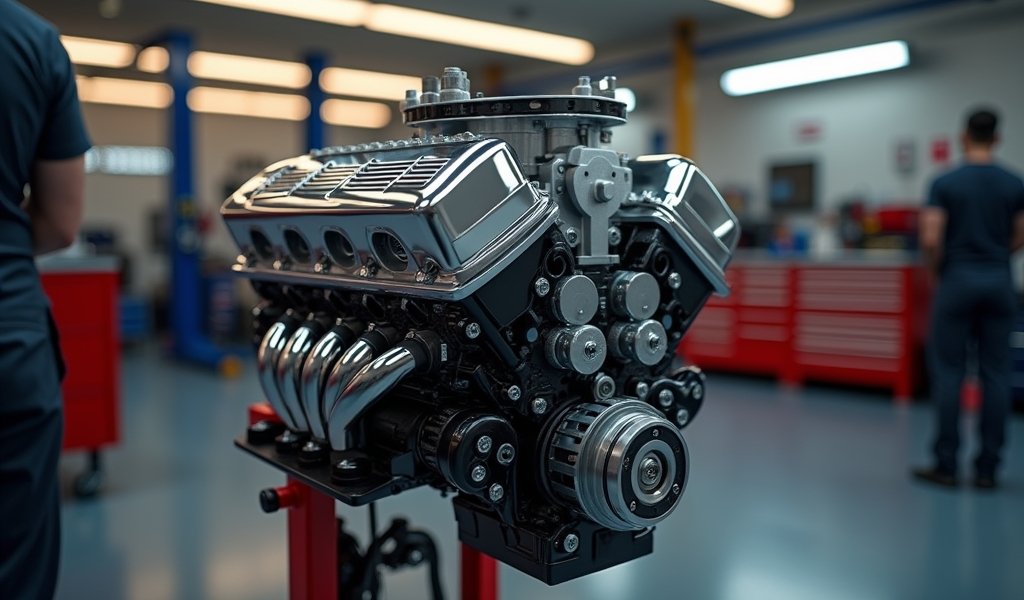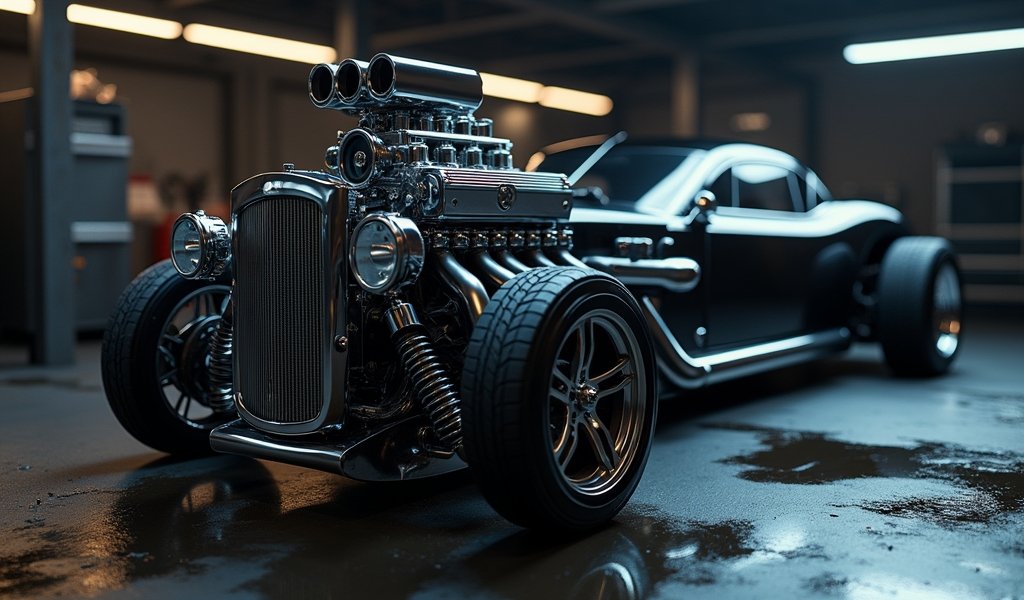Overview
This article explains how rocker arm ratios affect engine performance through valve lift and timing, with three key tips: measure components precisely, select ratios appropriate for your specific engine setup, and consider installation factors like pushrod length and valve spring pressure. Proper rocker arm ratio calculations can yield 15-25 horsepower gains in naturally aspirated engines, but require careful attention to avoid common mistakes such as relying on manufacturer specifications or overlooking increased stress on valvetrain components.
Table of Contents
- Understanding Rocker Arm Ratios
- Why Rocker Arm Ratios Matter
- Tip 1: Measuring Accurately for Precise Calculations
- Tip 2: Choosing Optimal Ratios for Your Engine
- Tip 3: Considering Installation Aspects
- Common Mistakes to Avoid When Calculating Rocker Arm Ratios
- Real-World Performance Impacts of Rocker Arm Ratios
- Conclusion
- Frequently Asked Questions
Understanding Rocker Arm Ratios
When it comes to maximizing your engine’s performance, rocker arm ratio calculation is one of those seemingly small details that can make a world of difference. I’ve spent years working on engines, and let me tell you – getting your rocker arm ratio right can be the difference between a sluggish engine and one that roars to life with impressive power.
In the simplest terms, rocker arm ratio is the relationship between how far the valve moves compared to how far the pushrod moves. Think of it as a mechanical advantage system. If you have a 1.6:1 ratio, that means for every inch the pushrod moves, the valve will move 1.6 inches. Pretty straightforward, right?
But here’s where many folks go wrong – they either ignore rocker ratios completely or choose them based on what their buddy recommended without understanding the science behind it. I’m going to walk you through the ins and outs of properly calculating these ratios, just like I would explain it to a friend in my garage.
Why Rocker Arm Ratios Matter
Before diving into calculations, let’s understand why we should care about rocker arm ratios in the first place. The ratio directly affects three crucial aspects of your engine’s performance:
- Valve lift (how far your valves open)
- Valve timing (when and how quickly valves open and close)
- Overall engine breathing efficiency
Higher ratios typically increase valve lift and can make your engine breathe better at higher RPMs. This is why performance enthusiasts often look to increased ratios when building high-revving engines. However, it’s not as simple as “bigger is better” – there’s a sweet spot for every engine setup.
When building a street engine that needs good low-end torque, extremely high ratios might actually hurt performance. On the other hand, if you’re building a racing engine with specific final drive ratios, higher rocker ratios might be exactly what you need.
Changing your rocker ratio also affects valve spring pressure, valve train stability, and even the geometry of how your rocker arms interact with your valves. It’s a domino effect that ripples through your entire valve train.

Tip 1: Measuring Accurately for Precise Calculations
Let’s get our hands dirty with the first and most crucial tip: accurate measurement. I can’t tell you how many times I’ve seen folks mess up their builds because they eyeballed measurements or relied on package specifications that weren’t quite right.
To accurately calculate rocker arm ratio, you need to measure two key distances:
- The distance from the rocker arm pivot point to the pushrod cup (A)
- The distance from the rocker arm pivot point to the valve stem contact point (B)
The ratio is simply B divided by A. For example, if the distance to the pushrod is 1 inch and the distance to the valve is 1.6 inches, your ratio is 1.6:1.
Here’s where precision matters: even a slight error in measurement can significantly impact your calculations. I recommend using a high-quality digital caliper rather than a standard ruler. Take multiple measurements and average them for best results.
When measuring existing rocker arms, clean them thoroughly first. Carbon buildup or oil can affect your measurements. For the most accurate results, measure with the rocker arm positioned at the mid-lift point of the valve’s travel – this accounts for the slight arc the rocker arm travels through.
According to research from the Society of Automotive Engineers, a measurement error of just 0.5mm can change effective valve lift by up to 0.2mm – potentially costing you valuable performance.
Tip 2: Choosing Optimal Ratios for Your Engine
Now that we know how to calculate the ratio, let’s talk about choosing the right one for your specific engine. This isn’t a one-size-fits-all situation – your optimal ratio depends on several factors:
- Engine type and displacement
- Intended use (street, track, towing, etc.)
- Camshaft profile
- RPM range you’ll be operating in
- Existing valve train components
For most stock replacement applications, sticking with the factory ratio is a safe bet. However, if you’re building for performance, you might want to consider bumping up the ratio. Small-block Chevy engines, for instance, typically come with 1.5:1 ratios from the factory, but many performance builds benefit from going to 1.6:1 or even 1.7:1.
Here’s a quick rule of thumb I share with my customers: for every 0.1 increase in rocker ratio, you’ll see approximately 4-5% increase in valve lift. So moving from a 1.5:1 to a 1.6:1 ratio gives you around 6-7% more lift without changing your camshaft.
Be aware that increasing your rocker ratio also effectively advances your valve timing slightly. This creates an interesting opportunity to fine-tune your engine’s powerband by adjusting your gear ratios in conjunction with rocker arm ratios.
When selecting ratios, don’t forget to consider valve spring pressure. Higher ratios mean more lift, which requires springs with adequate tension throughout the increased range of motion. If your springs aren’t up to the task, you’ll run into valve float issues at higher RPMs.
Tip 3: Considering Installation Aspects
My third tip focuses on what happens after you’ve calculated your ideal ratio – the installation considerations that many enthusiasts overlook. Trust me, I’ve seen plenty of perfectly calculated setups fail because of poor installation practices.
First, understand that changing rocker ratios often requires complementary modifications:
- Pushrod length may need adjustment
- Valve spring pressure might need to be increased
- Piston-to-valve clearance should be rechecked
- Rocker arm geometry needs verification
One critical aspect is maintaining proper rocker arm geometry. The rocker arm should contact the valve stem tip in the center and roll across it as the valve opens and closes. Improper geometry leads to accelerated wear and potential failure.
When installing new rocker arms with different ratios, you’ll almost certainly need to adjust pushrod length. Too short, and you’ll have inadequate preload on the lifters. Too long, and you risk binding the valvetrain or creating excessive preload.
A quick tip from the shop: after installation, rotate your engine through at least two complete revolutions by hand before starting it. This simple step has saved many engines from catastrophic damage due to unexpected interferences.
The proper inspection of your entire valve train system is essential when changing rocker arm ratios. Component interaction in the valve train is like a precisely choreographed dance – change one dancer’s moves, and everyone else needs to adjust too.

Common Mistakes to Avoid When Calculating Rocker Arm Ratios
After working on countless engines, I’ve noticed some recurring mistakes that even experienced builders make when calculating and implementing rocker arm ratios. Let’s make sure you don’t fall into these traps.
The most common mistake is assuming the manufacturer’s stated ratio is exact. I’ve measured plenty of “1.6 ratio” rockers that actually measure 1.58:1 or 1.63:1. Always verify with your own measurements – it’s the only way to be sure.
Another frequent error is forgetting that changing rocker ratios affects your valve timing events. A higher ratio effectively advances your valve timing slightly, which might require camshaft adjustments to maintain your intended powerband.
Many builders also overlook the increased stress that higher ratios place on other valvetrain components. Your pushrods, lifters, and valve springs will all experience increased forces. What worked fine with 1.5:1 rockers might fail with 1.7:1 ratios if you don’t upgrade accordingly.
Don’t forget about clearance issues either. Higher ratios mean more valve lift, which could lead to piston-to-valve contact if you haven’t checked clearances. I always recommend doing a thorough valve-to-piston clearance check anytime you modify your rocker arm ratios.
According to Engine Labs research, improper rocker arm setup contributes to over 30% of premature valvetrain failures in performance engines. That’s why getting your calculations right is so important.
Real-World Performance Impacts of Rocker Arm Ratios
Let’s talk about what you’ll actually feel when you get your rocker arm ratios right. After all, we’re not just doing math for fun – we want real-world performance gains!
In most naturally aspirated engines, optimizing your rocker arm ratio can yield noticeable improvements in throttle response and top-end power. I’ve seen proper rocker arm ratio changes add 15-25 horsepower to otherwise stock engines – not bad for a relatively affordable modification.
Where you’ll notice the difference most depends on the direction you take with your ratios. Higher ratios typically shift your power band higher in the RPM range, giving you more top-end pull at the expense of some low-end torque. Lower ratios do the opposite, enhancing low-end grunt while potentially sacrificing some high-RPM breathing efficiency.
Fuel efficiency can also be affected by rocker arm ratios. With properly matched components, optimized ratios can improve volumetric efficiency, potentially giving you slightly better fuel economy under normal driving conditions. However, if you’re like most of my customers, you’ll be having too much fun with the extra power to notice any fuel savings!
Engine longevity is another consideration. Contrary to what some might think, a properly calculated and installed higher-ratio rocker setup can actually reduce valve train stress in some applications. By allowing the valve to open and close more gradually (despite opening further), you can reduce the peak acceleration forces on the valve.
The real magic happens when you match your rocker arm ratios to your specific engine build, driving style, and performance goals. It’s this customization that separates good builds from great ones.
Conclusion
Rocker arm ratio calculation might seem like a small detail in the grand scheme of engine building, but as we’ve explored, it’s a critical component that influences everything from valve lift to engine longevity. Getting it right requires careful measurement, thoughtful selection based on your specific needs, and proper installation.
The three key tips we’ve covered – measuring accurately, choosing optimal ratios for your engine, and considering all installation aspects – provide a solid foundation for maximizing your engine’s potential through proper rocker arm setup. Remember that even small calculation errors can lead to significant performance differences or component failures.
Whether you’re restoring a classic to factory specifications or building a high-performance monster, understanding and correctly calculating your rocker arm ratios will help ensure your engine runs at its best. Take your time, be precise with your measurements, and don’t hesitate to consult with experts if you’re unsure about any aspect of the process.
Engine building is as much art as science, and rocker arm ratio selection is a perfect example of where these two worlds meet. With the knowledge you’ve gained from this guide, you’re well-equipped to make informed decisions that will help your engine breathe better, produce more power, and potentially even last longer. That’s a winning combination in my book!
Frequently Asked Questions
What is the formula for calculating rocker arm ratio?
The formula is the distance from pivot to valve contact point divided by the distance from pivot to pushrod contact point. For example, if these measurements are 1.6″ and 1.0″ respectively, your ratio is 1.6:1.
Does increasing rocker arm ratio increase horsepower?
Yes, increasing rocker ratio typically increases horsepower by improving valve lift and engine breathing. However, gains depend on complementary modifications and might shift your powerband higher in the RPM range.
How much valve lift does a 1.6 rocker add?
A 1.6 rocker adds approximately 6-7% more valve lift compared to a 1.5 rocker. For instance, a cam with 0.450″ lift at the valve with 1.5 rockers would yield about 0.480″ lift with 1.6 rockers.
Can I mix different rocker arm ratios on intake and exhaust?
Yes, many performance engines use different ratios for intake and exhaust valves. This allows for customizing breathing characteristics, often with higher ratios on exhaust valves to improve scavenging.
How often should rocker arms be replaced?
Quality rocker arms typically last 100,000+ miles in street applications with proper maintenance. Performance applications may require more frequent inspection, especially with higher ratios that increase component stress.

